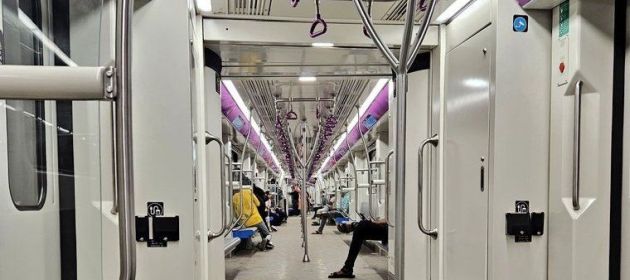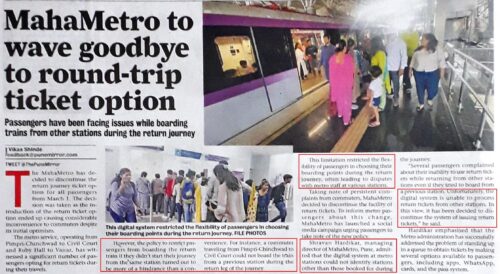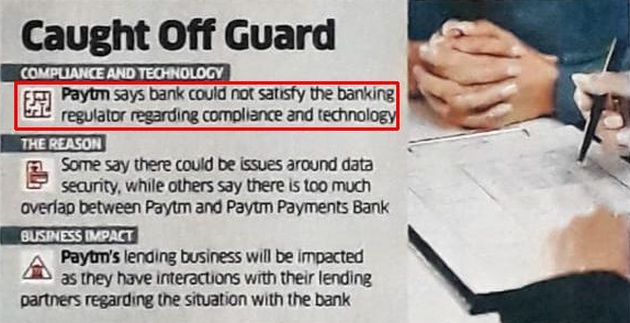I described ticketing problems with Pune Metro in my previous posts titled Pune Metro First Impressions and Pune Metro Second Impressions.
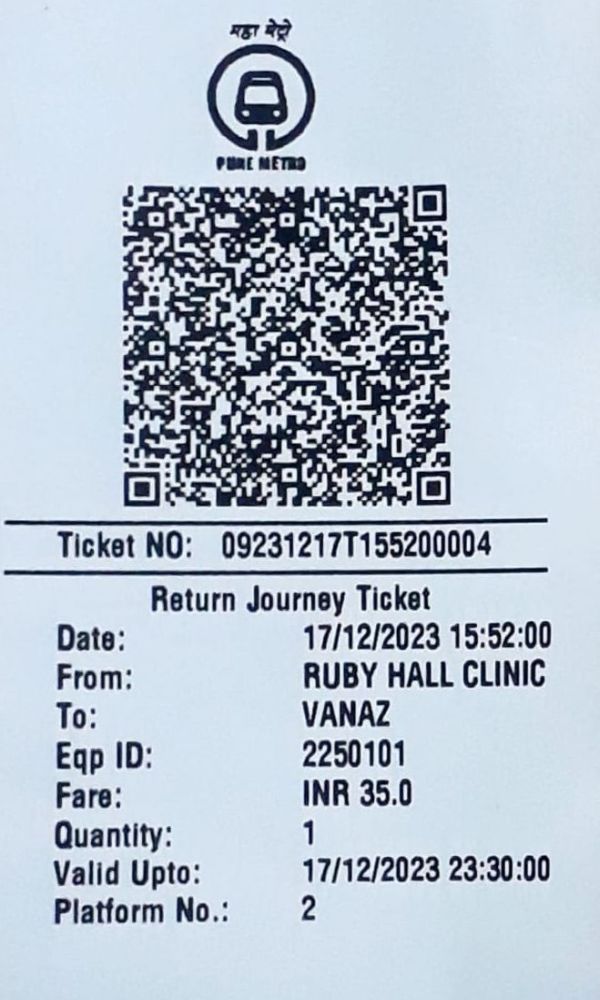 I experienced another ticketing snafu on my third trip.
I experienced another ticketing snafu on my third trip.
I bought a return ticket from Ruby Hall Clinic to Vanaz (the two terminuses of the Aqua Line). I got off at Vanaz Station and thought of going around the neighborhood. In the process, I ended up walking all the way to the next station Anand Nagar. I decided to commence my return trip from there instead of going back to Vanaz.
When I scanned my ticket at Anand Nagar, the turnstile beeped red! Which is strange since Anand Nagar in on the way from Vanaz to Ruby Hall Clinic. Logically, the return ticket should work not only at Vanaz but at every station en route Vanaz and Ruby Hall Clinic including Anand Nagar – but it did not.
According to the turnstile inspector, tickets can be used only at the station mentioned.
 So I had to buy another one way ticket from Anand Nagar to Ruby Hall Clinic.
So I had to buy another one way ticket from Anand Nagar to Ruby Hall Clinic.
While the extra cost is not a big deal, I’m sharing this experience just in case somebody wants to use this data point to reverse-engineer the architecture of the ticketing system. My guess: It’s decentralized and not very intelligent. Not that that’s such a bad thing.
Also, the return ticket flashed red when I scanned it at Ruby Hall Clinic at the end of my journey. Which makes sense since it was not scanned in at Vanaz on my return trip. So the ticketing system is not all that dumb either.
There’s some sobering news about Pune Metro’s offtake: According to Pune Mirror, “Pune Metro has lost its popularity”. Both number of passengers and revenue reportedly fell drastically in December.
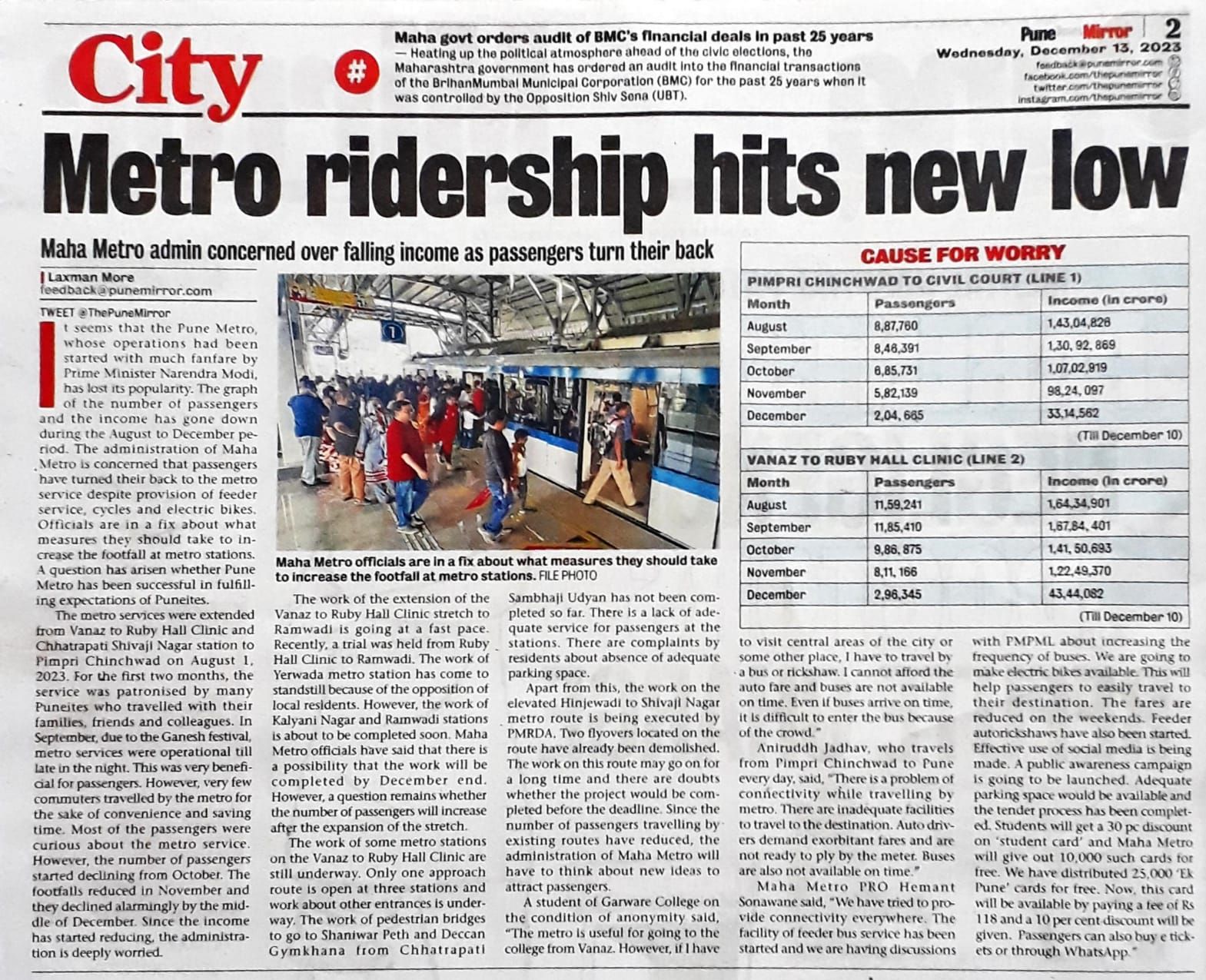
Puneites on X (fka Twitter) are blaming lack of last mile connectivity for the decline in metro usage.
@sudhirmehtapune: It’s alarming how the last-mile connectivity using electric buses and other EVs for our #Metro Rail Projects has been consistently overlooked.
I don’t buy this. In my experience with metros in many cities worldwide, last mile connectivity is never a part of metro. I’m glad the honcho of a metro company made that clear to a banker doing due diligence.
@ItheHAK: “Last mile… what’s that? It’s not our responsibility” was response of Bengaluru Metro MD when I asked this question as a State Bank of India official during a due diligence session carried out for its funding proposal. My pen fell off my hand – as also the loan proposal.
I agreed with the MD.
@s_ketharaman: He IS right. Last mile connectivity is not part of metro.
The banker was not impressed with my stance.
@ItheHAK: Hmmm. Being a promoter of high capex project like metro, without last mile infra and it’s implementation in place, you are working in the dark and will most likely take everyone down including your investors … a lose-lose analogy. No private money touches it.
I totally agreed with him.
@s_ketharaman: You are. You may. True. That’s why when people drink the Kool-Aid of infra development, I point out that you don’t go bankrupt when you take a loan but only when you need to repay it, on which count, it’s very early days in India.
In cities with vibrant metros, passengers walk or take an auto-rickshaw or make some other arrangements on their own to reach the nearest metro station. Metros don’t pick up passengers from home and drop them in the office. (They also walk a lot inside the tube stations, more on that in a bit.)
Can be. In fact, supposed to be within walking distance (1-2kms). London Tube is. I've heard that so is Delhi Metro. Will take a long time before that happens in newer metro cities.
— Ketharaman Swaminathan (@s_ketharaman) December 17, 2023
Another feature of metros is interchange. For the uninitiated, metros are radial and require passengers to get off at the intersection of one line with another to travel from Station A on one line to Station B on another line. In the case of Pune Metro, the interchange happens at Civil Court station. If you wish to go from Ruby Hall Clinic to PCMC, you need to take the Aqua Line (Ruby Hall Clinic to Vanaz), get off at Civil Court station, walk quite a bit to the other platform, and catch the Purple Line (Swargate to PCMC) to PCMC. Apart from walking to the station, interchange requires people to walk quite a bit inside the station as well.
While interchange and the ensuing walk is par for the course in cities with vibrant public transport mindset, I’m guessing it won’t find favor among people who’re used to going point-to-point via private transport all their life.
I have two datapoints that reinforce my prediction:
- When I was standing in the line to buy my ticket at Ruby Hall Clinic, a passenger asked me why the display didn’t show PCMC station. I told him that, while he could buy a ticket for PCMC at the same counter, he’d need to interchange at Civil Court station to go to PCMC. He mumbled something under his breath and walked out of the station.
- A friend of mine lives near Vanaz and has made 10+ trips on the Aqua Line to Ruby Hall Clinic. When I asked him if he’d traveled on the Purple Line to, say, PCMC, he was palpably overwhelmed about the need for interchange and told me, “Heck no”.
In my opinion, expecting the metro to provide last mile connectivity and interchange-free point-to-point connection reflects a lack of public transport culture.
While last mile connectivity options like bus and tram / streetcar have been brought together under one common transport operator in some countries (e.g. TfL in London, RMV in Frankfurt), they have not in others (e.g. USA, Canada). Where they have, it happened after decades; and, where they have not, it hasn’t happened even after half a century of the metro’s existence. If it happens in Pune / India, passengers should treat that as a bonus but not make that as a precondition for using the metro.
Instead of making haphazard attempts to provide last mile connectivity, cities should focus on instilling public transport culture among their residents so that they don’t ask their metro operators for the moon.
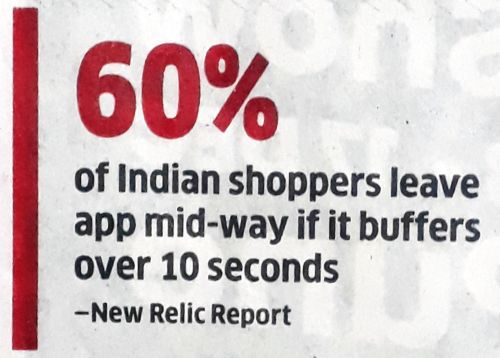 Traditionally, Indian consumers tolerate a lot of friction in websites and apps compared to consumers in, say, USA. Of late, that’s changing. I’m seeing growing evidence that Indian consumers are increasingly losing patience with apps that are slow, buggy and have poor UX. According to a report by New Relic, 60% of Indian shoppers leave an app midway if it buffers over 10 seconds.
Traditionally, Indian consumers tolerate a lot of friction in websites and apps compared to consumers in, say, USA. Of late, that’s changing. I’m seeing growing evidence that Indian consumers are increasingly losing patience with apps that are slow, buggy and have poor UX. According to a report by New Relic, 60% of Indian shoppers leave an app midway if it buffers over 10 seconds.
This got me wondering if the decline in footfall of Pune Metro has nothing to do with last mile connectivity issues and everything to do with the average metro rider getting peeved with its buggy ticketing system.
If so, that would be good news. Unlike public transport culture, which will take generations to develop, bugs in the ticketing system can be fixed quickly.
UPDATE DATED 24 FEBRURY 2024:
The above ticketing snafu has apparently sparked off a big controversy.
When my return ticket did not work at Anand Nagar, I guessed that the ticketing system was “decentralized and not very intelligent”. My wild speculation is confirmed by Mr. Shravan Hardikar, Managing Director, of Pune Metro in today’s edition of Pune Mirror:
The digital (ticketing) system at metro stations can’t identify stations other than those booked for.
I shrugged off the extra cost when I had to buy another ticket at Anand Nagar. But, apparently, many Puneites have made a big issue of it, “leading to disputes with metro staff at various stations”.
I also speculated that this was a bug in the ticketing system that could be fixed quickly. Unfortunately, I’m wrong on that count. Going by the fact that Pune Metro has withdrawn the return ticket booking feature, this appears to be a feature, not a bug.
If you ask me, this comes across as the height of knee jerk reaction. But it equally well reeks of the depth of cheapskate behavior on the part of passengers who whine about losing 20-odd bucks. Not sure if this is yet another sign of lack of public transport mindset or something deeper. Either way, it’s not a good thing for the prospects of infrastructure development in Pune.
